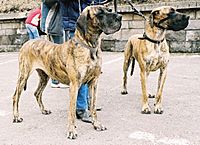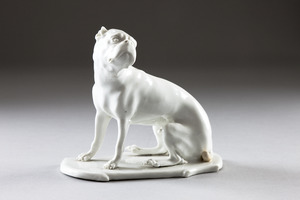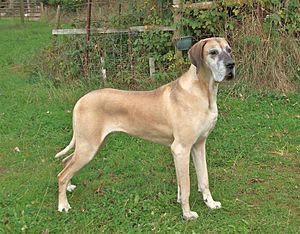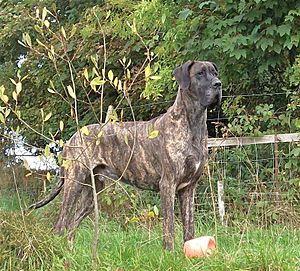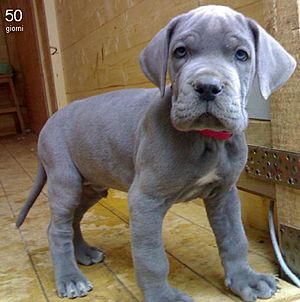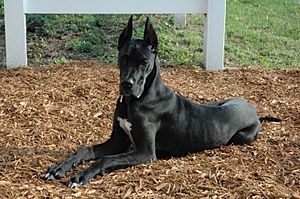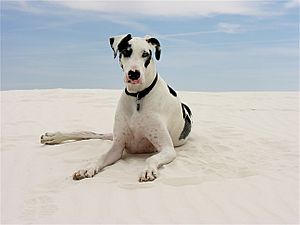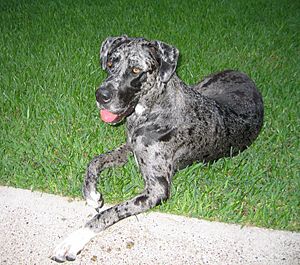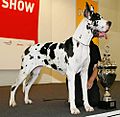Great Dane facts for kids
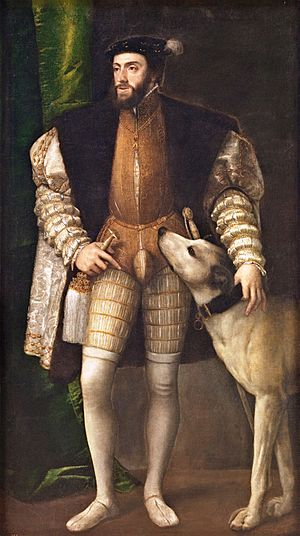
The Great Dane is a large breed of dog. They are about 2 feet (61 cm) or taller at the shoulder. Great Danes can have coats of a fawn color, black, Harlequin (a combination of black and white spots), blue, brindle, or mantle. The females are usually smaller and weight on an average of 110–132 pounds (50–60 kg). Males are slightly larger, about 150 pounds (68 kg) or more.
Contents
History
Large boarhounds resembling the Great Dane appear in ancient Greece, in frescoes from Tiryns dating back to the 14th–13th centuries BC.
These large boarhounds continue to appear throughout ancient Greece in subsequent centuries up to the Hellenistic era. In Austria and Germany the Molossian hound, Suliot dog, and specific imports from Greece were used in the 18th century to increase the stature of the boarhounds whereas, in Ireland, it was done for the wolfhounds.
Bigger dogs are depicted on numerous runestones in Scandinavia, on coinage in Denmark from the fifth century AD, and in the collection of Old Norse poems, known in English as Poetic Edda. The University of Copenhagen Zoological Museum holds at least seven skeletons of very large hunting dogs, dating from the fifth century BC to 1000 AD.
Hunting dog
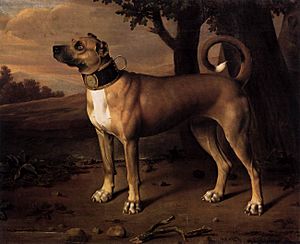
In the middle of the 16th century, the nobility in many countries of Europe imported strong, long-legged dogs from England, which were descended from crossbreeds between English Mastiffs and Irish Wolfhounds.
The dogs were used for hunting bear, boar, and deer at princely courts, with the favorites staying at night in the bedchambers of their lords. These Kammerhunde (chamber dogs) were outfitted with gilded collars, and helped protect the sleeping princes from assassins.
While hunting boar or bears, the Englische Dogge was a catch dog used after the other hunting dogs to seize the bear or boar and hold it in place until the huntsman was able to kill it. When the hunting customs changed, particularly because of the use of firearms, many of the involved dog types disappeared. The Englische Dogge became rare, and was kept only as a dog of hobby or luxury.
Name change
In the 19th century, the dog was known as a "German boarhound" in English-speaking countries. Some German breeders tried to introduce the names "German Dogge" and "German Mastiff" on the English market, because they believed the breed should be marketed as a dog of luxury and not as a working dog. However, due to the increasing tensions between Germany and other countries, the dog later became referred to as a "Great Dane", after the grand danois in Buffon's Histoire naturelle, générale et particulière in 1755.
Description
The Great Dane is a large German domestic dog (Canis lupus familiaris) known for its giant size.
As described by the American Kennel Club:
The Great Dane combines, in its regal appearance, dignity, strength, and elegance with great size and a powerful, well-formed, smoothly muscled body. It is one of the giant working breeds, but is unique in that its general conformation must be so well balanced that it never appears clumsy, and shall move with a long reach and powerful drive. The Great Dane is a short-haired breed with a strong, galloping figure.
In the ratio between length and height, the Great Dane should be square. The male dog should not be less than 30 in (76 cm) at the shoulders, a female 28 in (71 cm). Danes under minimum height are disqualified. From year to year, the tallest living dog is typically a Great Dane. Previous record holders include Gibson, Titan, and George; however, the current record holder is a black Great Dane named Zeus that stood 111.8 cm (44.0 in) at the shoulder before his death in September 2014. He was also the tallest dog on record (according to Guinness World Records), beating the previous holder, the aforementioned George that stood 109.2 cm (43.0 in) at the shoulder.
The minimum weight for a Great Dane over 18 months is 120 lb (54 kg) for males, 100 lb (45 kg) for females. Unusually, the American Kennel Club dropped the minimum weight requirement from its standard. The male should appear more massive throughout than the female, with a larger frame and heavier bone.
Great Danes have naturally floppy, triangular ears. In the past, when Great Danes were commonly used to hunt boars, cropping of the ears was performed to make injuries to the dogs' ears less likely during hunts. Now that Danes are primarily companion animals, cropping is sometimes still done for traditional and cosmetic reasons. In the 1930s when Great Danes had their ears cropped, after the surgery, two devices called Easter bonnets were fitted to their ears to make them stand up. Today, the practice is common in the United States, but much less common in Europe. In some European countries such as the United Kingdom, Ireland, Denmark, and Germany, and parts of Australia and New Zealand, the practice is banned or controlled to only be performed by veterinary surgeons.
Coat
The three varieties have five to six (depending on the standard) show-acceptable coat colors:
- Fawn and brindle
- Fawn: The colour is yellow gold with a black mask. Black should appear on the eye rims and eyebrows, and may appear on the ears.
- Brindle: The colour is fawn and black in a chevron stripe pattern. Often, also, they are referred to as having a stripe pattern.
- Harlequin and black
- Black: The colour is a glossy black. White markings on the chest and toes are not desirable and considered faults.
- Harlequin: The base colour is pure white with black torn patches irregularly and well distributed over the entire body; a pure white neck is preferred. The black patches should never be large enough to give the appearance of a blanket, nor so small as to give a stippled or dappled effect. Eligible, but less desirable, are a few small grey patches (this grey is consistent with a merle marking) or a white base with single black hairs showing through, which tend to give a salt and pepper or dirty effect.
Grey merle (Grautiger) dogs are acceptable in conformation shows under the FCI as the grey merle dogs can produce correctly marked black/white harlequin dogs, depending on the combinations. The aim for deleting the colour grey merle as a disqualifying fault is to provide a wider gene pool. Their status is that they are "neither desirable nor to be disqualified". Consequently, this colour must never obtain the highest grading at dog shows. - Mantle (in some countries referred to as Bostons due to the similar coloration and pattern as a Boston Terrier): The colour is black and white with a solid black blanket extending over the body; black skull with white muzzle; white blaze is optional; whole white collar preferred; a white chest; white on part or whole of forelegs and hind legs; white tipped black tail. A small white marking in the black blanket is acceptable, as is a break in the white collar.
- Blue: The colour is a pure steel blue. White markings at the chest and toes are not desirable and considered faults.
Other colours occur occasionally, but are not acceptable for conformation showing, and they are not pursued by breeders who intend to breed show dogs. These colours include white, fawnequin, brindlequin, merle, merlequin, blue merle, chocolate and fawn mantle. The white Great Dane coloring is typically associated with vision and hearing impairment.
Temperament
The Great Dane's large and imposing appearance belies its friendly nature. They are known for seeking physical affection with their owners, and the breed is often referred to as a "gentle giant".
Great Danes are generally well disposed toward other dogs, other noncanine pets, and familiar humans. They generally do not exhibit extreme aggressiveness or a high prey drive. The Great Dane is a very gentle and loving animal and with the proper care and training is great around children, especially when being raised with them. However, if not properly socialized, a Great Dane may become fearful or aggressive towards new stimuli, such as strangers and new environments.
Great Danes are a breed recommended for families provided that they get trained early and onwards, regarded by animal experts due to their preference for sitting on and leaning against owners as "the world's biggest 'lapdog'."
Exercise
Like most dogs, Great Danes require daily walks to maintain their health. However, it is important not to over exercise this breed, particularly when young. Great Dane puppies grow very large, very fast, which puts them at risk of joint and bone problems. Because of a puppy's natural energy, Dane owners often take steps to minimize activity while the dog is still growing.
Given their large size, Great Danes continue to grow (mostly gaining weight) longer than most dogs. Even at one year of age, a Great Dane continues to grow for several more months.
Images for kids
-
Wall painting fragments with a representation of a wild boar hunt. From the later Tiryns palace (National Archaeological Museum of Athens)
See also
 In Spanish: Gran danés para niños
In Spanish: Gran danés para niños


